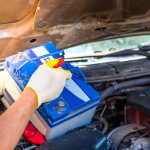As the chill of winter settles in, the last thing you want is to jump into a cold car, only to find that your heater is blowing frigid air instead of warmth. A malfunctioning heater can turn your daily commute or holiday road trip into an uncomfortable experience, but diagnosing the problem doesn’t have to be daunting.
In this article, we’ll guide you through the common signs of car heater system failure, the potential culprits behind those frosty vents, and easy steps you can take to troubleshoot the issue. Whether you’re a seasoned car enthusiast or a casual driver, our friendly tips will help ensure that you stay cozy and safe on the road this winter. So grab a warm drink, and let’s get started on keeping your car heater in tip-top shape!
Table of Contents
- Understanding the Common Symptoms of Heater System Failure
- Essential Tools for Diagnosing Your Cars Heating System
- Step-by-Step Guide to Troubleshooting Heating Issues
- Preventative Maintenance Tips to Keep Your Heater Running Smoothly
- Q&A
- Final Thoughts

Understanding the Common Symptoms of Heater System Failure
Experiencing discomfort in your vehicle during the colder months can often be attributed to heater system failure. One of the most prevalent indicators is inadequate heating, where the system struggles to produce warm air, or it may only emit lukewarm air. This can be caused by a variety of issues such as low coolant levels or a malfunctioning thermostat. Keep an eye out for unusual odors, which can suggest a coolant leak or burnt components. Moreover, if you notice unusual noises when the heater is engaged, it might point to issues with the fan or the blower motor.
In addition to poor heating, other symptoms can signal trouble within your heater system. For instance, if the windshield fogs up excessively or takes longer to defog, it might indicate that the heater core is clogged or failing. A sudden spike in your engine temperature gauge can also be alarming—this could signify a coolant blockage or a more severe issue within the cooling system. Be mindful of these signs and consider them as cues to act before the problem escalates. Here’s a quick reference table of common symptoms and their possible causes:
| Symptom | Possible Cause |
|---|---|
| Inadequate heating | Low coolant levels or faulty thermostat |
| Unusual odors | Coolant leak or burning parts |
| Excessive windshield fogging | Clogged or failing heater core |
| Engine temperature spikes | Coolant blockage or cooling system issues |
Essential Tools for Diagnosing Your Cars Heating System
Diagnosing your car’s heating system can be a straightforward process, provided you have the right tools at hand. To begin, keep a digital multimeter handy. This versatile tool will help you check electrical connections and ensure your heating components are receiving the correct voltage. Next, a mechanical thermometer is essential for measuring the temperature of the coolant, which can indicate whether the heater core is functioning properly. Additionally, a coolant pressure tester can help you identify leaks in the system, ensuring you maintain optimal performance.
Another valuable tool is an OBD-II scanner, which can read diagnostic trouble codes from the vehicle’s onboard computer. This can provide insight if there are any underlying issues affecting your heating system. Don’t forget about some basic hand tools, like wrenches and screwdrivers, for any necessary adjustments or repairs. having a work light will illuminate the often dim undersides of your vehicle, making it easier to diagnose problems effectively. With these essential tools, you’ll be well-equipped to tackle any heating system issues this winter.
Step-by-Step Guide to Troubleshooting Heating Issues
When you notice a lack of warmth from your car’s heater, it’s essential to begin your troubleshooting process methodically. Start by checking the thermostat; if it’s stuck open, the engine may not reach optimal temperatures, leading to ineffective heating. Look for signs of coolant leaks under the vehicle and inspect hoses for any cracks or damage. A well-functioning radiator cap is also crucial, as a faulty one can lead to a drop in pressure, preventing proper circulation of coolant. Additionally, ensure that the blower motor is operational. If you don’t hear a sound when the heater is turned on, the motor may be dead and require replacement.
Next, examine the heater core, which can often become clogged with debris over time. You can check for this by running the engine with the heater on and feeling for warm air from the vents. If the air is cool or lukewarm, the heater core might need a thorough flush. Look for signs of contaminated coolant, such as a brownish color or a sweet smell, indicating that a flush is necessary to restore efficiency. Don’t forget to verify the fuses and relays associated with the heating system; a blown fuse can disrupt functionality. A quick assessment of these components can save you time and ensure that you stay warm throughout the cold winter months.
Preventative Maintenance Tips to Keep Your Heater Running Smoothly
Regular maintenance is key to ensuring your heater operates efficiently throughout the winter months. Start by checking the coolant levels regularly, as low levels can hinder the heating system’s performance. It’s also essential to inspect the heater core for leaks or blockages, which can prevent warm air from circulating effectively. In addition, remember to replace the cabin air filter periodically to improve air quality and ensure optimal airflow into your vehicle’s interior.
Next, pay attention to your heater’s hoses and belts. Look for signs of wear, cracking, or leaks, as these can lead to significant problems if left unaddressed. Scheduling a professional inspection can save you from expensive repairs later on. It’s also a good idea to test the thermostat regularly, as a malfunctioning thermostat can cause your heater to underperform. Keeping these elements in check not only maximizes your comfort but also enhances the overall lifespan of your vehicle’s heating system.
Q&A
Q1: What are the common symptoms of a car heater system failure?
A1: The most noticeable symptoms include a lack of warm air blowing from the vents, air that feels cool even when the heater is on, or fluctuating temperatures. You might also notice unusual smells, sounds, or even a coolant leak under the dashboard, which could indicate a problem with the heater core.
Q2: How can I tell if the problem is with the heater itself or the engine?
A2: If your engine is not reaching its normal operating temperature, it could indicate a thermostat issue that affects the heater’s performance. To determine if it’s an issue with the heater or the engine, check the engine temperature gauge. If the engine is overheating or not warming up properly, focus on that issue first. If the engine is at a normal temperature but no warm air is coming from the heater, the problem likely lies within the heating system itself.
Q3: What steps can I take to troubleshoot my car’s heater?
A3: Begin by checking the coolant level in your radiator and overflow tank. Low coolant can cause your heater to malfunction. Next, inspect the heater control settings to ensure they are set correctly. If the temperature control knobs feel unresponsive, there may be an issue with the settings or the control panel. Lastly, check for any unusual noises or smells that could indicate a blockage or failure within the system.
Q4: How do I know if my heater core is clogged?
A4: A clogged heater core often presents symptoms such as a decrease in the heater’s efficiency or the presence of a sweet smell (due to leaking coolant). You can feel the hoses leading into and out of the heater core; if one is significantly cooler than the other, it might suggest a blockage. Additionally, if your windshield fogs up more than usual, this can indicate coolant leaking into the cabin, which points to a potential heater core issue.
Q5: Is it safe to drive a car with a malfunctioning heater?
A5: While it is generally safe to drive with a malfunctioning heater, it can become problematic in cold weather, as you may not have defrost capabilities for your windshield, impacting visibility. If you notice aroma of coolant inside your vehicle or a significant temperature fluctuation, it’s best to have the vehicle inspected to avoid further damage.
Q6: When should I seek professional help?
A6: If you’ve gone through basic troubleshooting and the heater still isn’t working, or if you encounter coolant leaks or persistent overheating, it’s time to consult a professional mechanic. Especially with systems like the heater core, which can be complex and involve draining coolant and disassembling parts of the dashboard, professional assistance will ensure it’s handled safely and effectively.
Q7: How can regular maintenance prevent heater issues?
A7: Regular vehicle maintenance is key! Ensure you keep up with coolant flushes, check the coolant level regularly, and replace the cabin air filter as needed. A well-maintained cooling system will help your heater perform optimally during the cold months.
Q8: What can I do if my heater fails suddenly in winter?
A8: If your heater fails unexpectedly, you can try using the defroster setting. This may help draw some warm air from the engine, providing a temporary solution. It’s also advisable to keep warm blankets or clothing in the car and avoid prolonged periods of driving without heat. Make an appointment with a mechanic at your earliest convenience to get it checked out.
Stay warm this winter and ensure your car’s heater is in top condition!
Final Thoughts
keeping your car’s heater in top shape is essential for a comfortable and safe driving experience during the chilly months. By understanding the common signs of heater system failure and conducting regular maintenance, you can address issues before they escalate. Remember to check your coolant levels, inspect the thermostat, and listen for any unusual noises that could indicate trouble. If you find yourself facing a more complex problem, don’t hesitate to consult a professional mechanic who can provide expert guidance. With these tips in hand, you’re well-equipped to ensure that your car remains a cozy refuge from the winter chill. Stay warm, drive safely, and enjoy the ride this season!











